#fpif
Explore tagged Tumblr posts
Text
Manifesto for an Ecosocial Energy Transition from the Peoples of the South
An appeal to leaders, institutions, and our brothers and sisters
More than two years after the outbreak of the COVID-19 pandemic—and now alongside the catastrophic consequences of Russia’s invasion of Ukraine—a “new normal” has emerged. This new global status quo reflects a worsening of various crises: social, economic, political, ecological, bio-medical, and geopolitical.
Environmental collapse approaches. Everyday life has become ever more militarized. Access to good food, clean water, and affordable health care has become even more restricted. More governments have turned autocratic. The wealthy have become wealthier, the powerful more powerful, and unregulated technology has only accelerated these trends.
The engines of this unjust status quo—capitalism, patriarchy, colonialism, and various fundamentalisms—are making a bad situation worse. Therefore, we must urgently debate and implement new visions of ecosocial transition and transformation that are gender-just, regenerative, and popular, that are at once local and international.
In this Manifesto for an Ecosocial Energy Transition from the Peoples of the South, we hold that the problems of the Global – geopolitical – South are different from those of the Global North and rising powers such as China. An imbalance of power between these two realms not only persists because of a colonial legacy but has deepened because of a neocolonial energy model. In the context of climate change, ever rising energy needs, and biodiversity loss, the capitalist centers have stepped up the pressure to extract natural wealth and rely on cheap labor from the countries on the periphery. Not only is the well-known extractive paradigm still in place but the North’s ecological debt to the South is rising.
What’s new about this current moment are the “clean energy transitions” of the North that have put even more pressure on the Global South to yield up cobalt and lithium for the production of high-tech batteries, balsa wood for wind turbines, land for large solar arrays, and new infrastructure for hydrogen megaprojects. This decarbonization of the rich, which is market-based and export-oriented, depends on a new phase of environmental despoliation of the Global South, which affects the lives of millions of women, men, and children, not to mention non-human life. Women, especially from agrarian societies, are amongst the most impacted. In this way, the Global South has once again become a zone of sacrifice, a basket of purportedly inexhaustible resources for the countries of the North.
A priority for the Global North has been to secure global supply chains, especially of critical raw materials, and prevent certain countries, like China, from monopolizing access. The G7 trade ministers, for instance, recently championed a responsible, sustainable, and transparent supply chain for critical minerals via international cooperation‚ policy, and finance, including the facilitation of trade in environmental goods and services through the WTO. The Global North has pushed for more trade and investment agreements with the Global South to satisfy its need for resources, particularly those integral to “clean energy transitions.” These agreements, designed to reduce barriers to trade and investment, protect and enhance corporate power and rights by subjecting states to potential legal suits according to investor-state dispute settlement (ISDS) mechanisms. The Global North is using these agreements to control the “clean energy transition” and create a new colonialism.
Governments of the South, meanwhile, have fallen into a debt trap, borrowing money to build up industries and large-scale agriculture to supply the North. To repay these debts, governments have felt compelled to extract more resources from the ground, creating a vicious circle of inequality. Today, the imperative to move beyond fossil fuels without any significant reduction in consumption in the North has only increased the pressure to exploit these natural resources. Moreover, as it moves ahead with its own energy transitions, the North has paid only lip service to its responsibility to address its historical and rising ecological debt to the South.
Minor changes in the energy matrix are not enough. The entire energy system must be transformed, from production and distribution to consumption and waste. Substituting electric vehicles for internal-combustion cars is insufficient, for the entire transportation model needs changing, with a reduction of energy consumption and the promotion of sustainable options.
In this way, relations must become more equitable not only between the center and periphery countries but also within countries between the elite and the public. Corrupt elites in the Global South have also collaborated in this unjust system by profiting from extraction, repressing human rights and environmental defenders, and perpetuating economic inequality.
Rather than solely technological, the solutions to these interlocked crises are above all political.
As activists, intellectuals, and organizations from different countries of the South, we call on change agents from different parts of the world to commit to a radical, democratic, gender-just, regenerative, and popular ecosocial transition that transforms both the energy sector and the industrial and agricultural spheres that depend on large-scale energy inputs. According to the different movements for climate justice, “transition is inevitable, but justice is not.”
We still have time to start a just and democratic transition. We can transition away from the neoliberal economic system in a direction that sustains life, combines social justice with environmental justice, brings together egalitarian and democratic values with a resilient, holistic social policy, and restores an ecological balance necessary for a healthy planet. But for that we need more political imagination and more utopian visions of another society that is socially just and respects our planetary common house.
The energy transition should be part of a comprehensive vision that addresses radical inequality in the distribution of energy resources and advances energy democracy. It should de-emphasize large-scale institutions—corporate agriculture, huge energy companies—as well as market-based solutions. Instead, it must strengthen the resilience of civil society and social organizations. Therefore, we make the following 8 demands:
We warn that an energy transition led by corporate megaprojects, coming from the Global North and accepted by numerous governments in the South, entails the enlargement of the zones of sacrifice throughout the Global South, the persistence of the colonial legacy, patriarchy, and the debt trap. Energy is an elemental and inalienable human right, and energy democracy should be our goal.
We call on the peoples of the South to reject false solutions that come with new forms of energy colonialism, now in the name of a Green transition. We make an explicit call to continue political coordination among the peoples of the south while also pursuing strategic alliances with critical sectors in the North.
To mitigate the havoc of the climate crisis and advance a just and popular ecosocial transition, we demand the payment of the ecological debt. This means, in the face of the disproportionate Global North responsibility for the climate crisis and ecological collapse, the real implementation of a system of compensation to the global South. This system should include a considerable transfer of funds and appropriate technology, and should consider sovereign debt cancellation for the countries of the South. We support reparations for loss and damage experienced by Indigenous peoples, vulnerable groups and local communities due to mining, big dams, and dirty energy projects.
We reject the expansion of the hydrocarbon border in our countries—through fracking and offshore projects—and repudiate the hypocritical discourse of the European Union, which recently declared natural gas and nuclear energy to be “clean energies.” As already proposed in the Yasuni Initiative in Ecuador in 2007 and today supported by many social sectors and organizations, we endorse leaving fossil fuels underground and generating the social and labor conditions necessary to abandon extractivism and move toward a post-fossil-fuel future.
We similarly reject “green colonialism” in the form of land grabs for solar and wind farms, the indiscriminate mining of critical minerals, and the promotion of technological “fixes” such as blue or grey hydrogen. Enclosure, exclusion, violence, encroachment, and entrenchment have characterized past and current North-South energy relations and are not acceptable in an era of ecosocial transitions.
We demand the genuine protection of environment and human rights defenders, particularly indigenous peoples and women at the forefront of resisting extractivism.
The elimination of energy poverty in the countries of the South should be among our fundamental objectives—as well as the energy poverty of parts of the Global North—through alternative, decentralized, equitably distributed projects of renewable energy that are owned and operated by communities themselves.
We denounce international trade agreements that penalize countries that want to curb fossil fuel extraction. We must stop the use of trade and investment agreements controlled by multinational corporations that ultimately promote more extraction and reinforce a new colonialism.
Our ecosocial alternative is based on countless struggles, strategies, proposals, and community-based initiatives. Our Manifesto connects with the lived experience and critical perspectives of Indigenous peoples and other local communities, women, and youth throughout the Global South. It is inspired by the work done on the rights of nature, buen vivir, vivir sabroso, sumac kawsay, ubuntu, swaraj, the commons, the care economy, agroecology, food sovereignty, post-extractivism, the pluriverse, autonomy, and energy sovereignty. Above all, we call for a radical, democratic, popular, gender-just, regenerative, and comprehensive ecosocial transition.
Following the steps of the Ecosocial and Intercultural Pact of the South, this Manifesto proposes a dynamic platform that invites you to join our shared struggle for transformation by helping to create collective visions and collective solutions.
We invite you to endorse this manifesto with your signature.
9 notes
·
View notes
Text
The Future of Techno-War - FPIF
CC 7 ILLEGAL DRONE WARS WAGED UPON BROWN PEOPLE BY CIA BILLIONAIRE BANKSTER DRONE HOBAMA
CC HOBAMA TV
CC COSMIC WW3 PER NOSTRADAMUS
CC AFRICOM
CC AMERIKKKA
0 notes
Text
The Weaponization of Food - FPIF
In case you're living under a rock. This is not to say that any specific nation, people are to be vilified. The propensity to amass power and oppress is pretty universal to humans in my opinion. This should never be allowed. That's why we have multilateral institutions. As people we collectively decide to say 'no' to sacrificing the marginalized so we can be comfortable. These choices define us and shape our future.
0 notes
Text
What is SEO
ido AID PIUAFPIUH FIUFP iuhfishf iuhadsifhup ififuh oaisuhf fssu pisuhfipuhf sfpih pifsf pifh isufhiufh ifpi safpiaufh f iasfiauh fahdf uauaoufdyoaufdyobf of afasufohafo fuhfo fouhfoas fouf oas foauhfouhf oiufh oasi foas foas foifhuoasif hoasfuhiufhhffhifhidfhiahf iafpias hfpiahfpiahfpiahf haisfuhaishfasi iahfaih aisufhai fifuhisaf psfifhifh asf asifuhi fpif pai fupifh pifhihfuaf ouqqwh ffqq hquhfqhq fqfhafaf f qi
0 notes
Photo





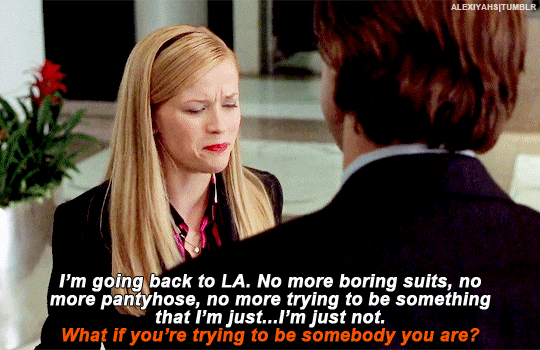

FAVORITE PAIRINGS IN FILM: »»» ELLE WOODS + EMMETT RICHMOND | LEGALLY BLONDE (2001)
#legallyblondeedit#legally blonde#legally blonde film#elle woods#ellewoodsedit#emmett richmond#emmettrichmondedit#filmedit#films#movieedit#mygifs#mygifs:film#mygifs:lb#fpif
262 notes
·
View notes
Text

Have a ref of,,,, the them
7 notes
·
View notes
Text
The RIMPAC exercise once again underscores the role of the islands and region in warfighting strategy as well as the complex and even paradoxical nature of “defending” and “protecting.” This is especially true for the island of Guam, the homeland of the indigenous CHamoru people. In Guam, military officials from the Joint Region Marianas assure the residents (and the indigenous CHamoru population) that the United States will continue to protect Guam against all threats, asking them to not be alarmed by military developments.[...]
The axis of the U.S. Indo-Pacific strategy seems to revolve around Guam. As a U.S. territory, Guam serves as a reliable location for logistics, power projection, and deterrence. Or, as the Hudson Institute puts it, “this US territory is essential to the security of the American citizenry.”[...]
High-ranking officials, such as former head of Indo-Pacific Command, Admiral Phil Davidson, have testified before Congress on the importance of Guam: “I have repeatedly stated the most important action we can take to increase the joint force’s lethality is to introduce a 360-degree, persistent, air and missile defense capability on Guam.” [...]
Guam’s role as a militarized, strategically located unincorporated territory has various cultural, environmental, and economic effects, including the occupation of 27 percent of the island’s land by the US military. The latest geopolitical maneuvering of great powers adds another element to the threat against Guam, which makes itself visible through the layers of missile defense. [...]
Guam’s role as a militarized, strategically located unincorporated territory has various cultural, environmental, and economic effects, including the occupation of 27 percent of the island’s land by the US military. The latest geopolitical maneuvering of great powers adds another element to the threat against Guam, which makes itself visible through the layers of missile defense.[...]
military officials have said, Guam is not a place to simply fight from, it must now be fought for. They stress the urgency and timely nature of defending the island’s vulnerabilities, while simultaneously arguing that this will not provoke China. Rather, Guam’s missile defense becomes a key to deterrence in the region. U.S. forces and facilities in the island would enable a drawn-out conflict, which China does not want. [...]
Resiliency in Guam military operations does not translate into resiliency for the island’s society. The threat of deterrence failing should send chills down our spines, but we should also consider who placed the target on our heads in the first place. The conversation about missile defense and Guam’s future in a conflict with China must include those who bask in the warm Guam sun, feel the Guam wind on their skin, or are rooted generations deep in the island’s soil.
20 Jul 2022
25 notes
·
View notes
Text
where is hawai'i? can you point to it on a map?
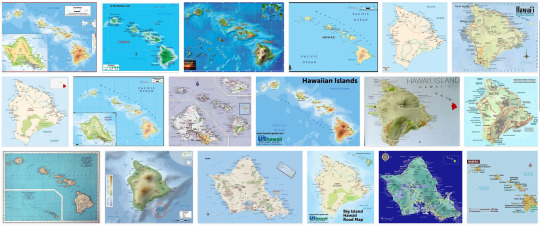
if someone asks you to point to hawai'i on a map, where would you point?
before colonization, there was (and continues to be) an island called "hawai'i". the entire chain of islands is called "hawaii" and there is a state called "hawaii" made up of a large number of those islands.
now, because there are too many things named "hawaii," the island of hawai'i is often called "the big island", because o'ahu, the island where the city of honolulu is located, is what many people think of when they think of "hawaii". it's a mess.
on top of that, we have the "main hawaiian islands" (aka "southeastern islands" aka "windward islands") vs the "outer islands" (aka "northwestern islands" aka "leeward islands").
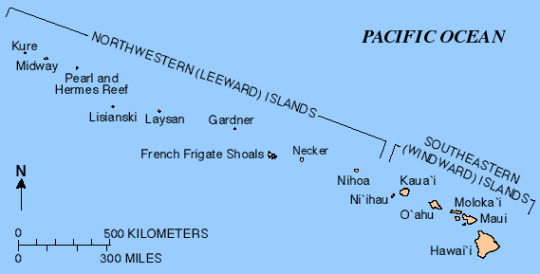
most maps of "hawaii" show only the "main" islands. the map above (created by USGS) shows more of the hawaiian islands, but omits the names of two of the islands in the "main" chain: lana'i & kaho'olawe. these are not insignificant omissions. lana'i is 98% owned by larry ellison, founder & chairman of oracle corporation. kaho'olawe has been relentlessly used & abused by the west. it has been used for ranchland, military training, and most notably, as a munitions testing site, resulting in the continued contamination of the island. after many years of protests & lawsuits by native hawaiians, the island is now only accessible by native hawaiians for cultural, spiritual, & subsistence reasons.
meanwhile, this tourist mug with a creepy colonial-style map of hawaii includes both kaho'olawe & lana'i. good job, tourist mug!

there are actually over a hundred islands in the hawaiian archipelago. the state of hawaii includes 137 of them (source). midway atoll (made up of 3 islands) is part of the archipelago, but not part of the state. it is one of america's territories: an unorganized unincorporated territory.
additionally, some of the islands "are too small to appear on maps, and others, such as Maro Reef, only appear above the water's surface during times of low tide. Others, such as Shark and Skate islands, have completely eroded away." [source: wikipedia page "list of islands of hawaii"].
in the course of writing this post, i failed to find a map that shows & names all the hawaiian islands and failed to even find a list of all of them (plus if an island only appears sometimes or has disappeared entirely, what do you even do with that?). if you find either or both of those, let me know in comments.
so where and what "hawaii" is remains a mystery.
but this has not prevented commercial & official interests from using maps of "hawaii" in all kinds of places! here on the islands, hawaii map imagery is all around.
maps are very common on tourist items:

the hawaiian telcom logo uses dots roughly arranged in the pattern of the islands on a map:

but i guess only five islands are worth including (i understand. branding needs come above all else!).
this souvenir cloth item is interesting because it includes all the main islands (including ni'ihau, lana'i, and kaho'olawe - which are often excluded), but smooshes them into the available space without much consideration for where they are in relation to each other:

the postcard above has the main islands in their rough places, but squishes them all together so that they fit in the space. also the islands are made more similar in size to each other so that you can better see the little illustrations.
here's a more "official" map to show where the islands "should be" in relation to each other, and their sizes relative to each other (although both of those can change depending on what projection the map uses):
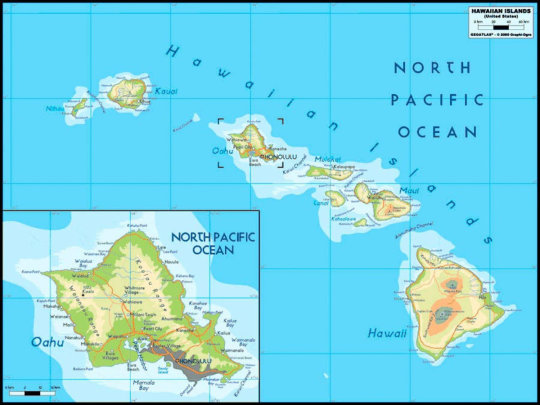
in my mind, though, the ultimate hawaii map fantasy lives on the ubiquitous reusable walmart cloth bag (available for 50 cents at checkout to all who have forgotten to bring the right number of bags. there's a plastic shopping bag ban in hawaii.):

in the walmart commercial universe (wcu), the only islands that exist are islands that have a walmart. the general outlines of the islands & their general orientation is preserved (along with a rough topology too!), attempting to convey a sense of adhering to a recognizable reality, but islands without a walmart have been not only omitted, but the space where they would be has been eliminated as well - as if they were never there to begin with. in the walmart version of reality, what makes something "hawaii" is whether or not it has a walmart on it.
i've had a lot of time to think about this remarkable image because i have a whole bunch of these bags. this is the bag of the people - everyone uses it for everything. the one in the above photo is in a typical state - pretty rough - because it probably came from the side of the road. you can almost always find one on the side of the road. so wherever you are, you are probably within sight of the walmart version of the islands.
so why does it matter whether or not you can point to "hawaii" on a map? well, maps are political documents, meaning that they reflect the vision of whoever has the power to put the map in front of your eyes. so if you're the one with the power to make some of the most commonly-seen maps of hawaii and you decide to remove a few islands, well that can really shape what people think "hawaii" is! we're a sea of islands - many people here have only ever been to one or two of the islands. if it wasn't on the map, you might not know that it existed at all.
hawaii is incredibly important to the united states, not just for tourism, but in terms of global strategy. it's the largest outpost of american power in the middle of the pacific. it puts america & its troops half an ocean closer to some of america's biggest competitors, most notably, china. it's a springboard to all the other island territories of the pacific (which you maybe haven't heard of because they almost never appear on maps):

once you see a map of all of america's territories in the pacific, along with the exclusive economic zones (eez) that extend out for 200 miles around each island, you start to get a better feel for the extent of america's power in the pacific.
when a place is left off the map, it can be easy to make it (including its people!) invisible. so if you're america, with bases across the islands of the pacific, with a nightmarish history of atomic weapons testing in the pacific (rendering islands uninhabitable and leaving both land and waters too contaminated for people to use), perhaps you might not want some of these places to appear on the map.
in Foreign Policy in Focus, Khury Petersen-Smith writes:
"Many of us living in North America who are concerned about climate change, for example, have a sense that Pacific Islands are facing particularly severe impacts from rising sea levels. But that knowledge tends to be vague and limited, as actual residents of these islands are rarely invited to the table to speak for themselves.
This is not accidental. Commenting during the Nixon administration on U.S. nuclear testing in the Marshall Islands, which share the same region of the Pacific as Guam, Henry Kissinger said “there are only 90,000 people out there. Who gives a damn?”
The U.S. has long had an interest in Marshallese and other Pacific Islanders remaining “out there” in the American mind. This marginalization helps allow the U.S. to carry out military operations in the region, along with policies that further climate change and other harms, while keeping most Americans unaware of these practices’ impacts in the Pacific." [FPIF]
often hawai'i (and alaska - which is in many ways similar to hawai'i in its relation to the contiguous US) doesn't even appear on national maps of the USA.
here's a screenshot from the new york times homepage on march 21, 2020, just as the coronavirus pandemic was beginning to spread:
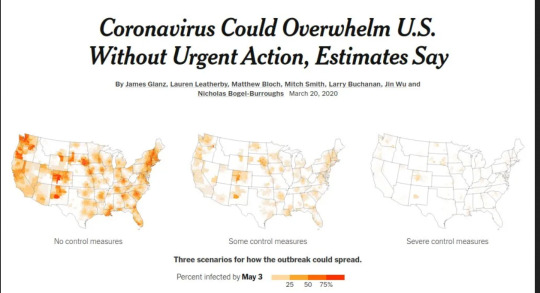
there is no alaska and no hawai'i on those maps. so if you were looking for information on the most important issue that was happening at the time, and you live in or are concerned about hawai'i and/or alaska, there would just be nothing. and what does it say about the people who run the top newspaper in america that they decided it was fine to omit these two states? are they not states? do they not matter? do the readers in those states not matter? and this is not an unusual thing at all. it happens all the time.
i'd like to finish by sharing with you a poem by CHamoru poet Craig Santos Perez. CHamoru are the indigenous people of the mariana islands (which include guam, saipan, tinian, rota, and others).
in this poem, Craig Santos Perez writes about not appearing on the map...
“Off-Island CHamorus”
My family migrated to California when I was 15 years old. During the first day at my new high school, the homeroom teacher asked: “Where are you from?” “The Mariana Islands,” I answered. He replied: “I’ve never heard of that place. Prove it exists.” And when I stepped in front of the world map on the wall, it transformed into a mirror: the Pacific Ocean, like my body, was split in two and flayed to the margins. I found Australia, then the Philippines, then Japan. I pointed to an empty space between them and said: “I’m from this invisible archipelago.” Everyone laughed. And even though I descend from oceanic navigators, I felt so lost, shipwrecked
on the coast of a strange continent. “Are you a citizen?” he probed. “Yes. My island, Guam, is a U.S. territory.” We attend American schools, eat American food, listen to American music, watch American movies and television, play American sports, learn American history, dream American dreams, and die in American wars. “You speak English well,” he proclaimed, “with almost no accent.” And isn’t that what it means to be a diasporic CHamoru: to feel foreign in a domestic sense.
Over the last 50 years, CHamorus have migrated to escape the violent memories of war; to seek jobs, schools hospitals, adventure, and love; but most of all, we’ve migrated for military service, deployed and stationed to bases around the world. According to the 2010 census, 44,000 CHamorus live in California, 15,000 in Washington, 10,000 in Texas, 7,000 in Hawaii, and 70,000 more in every other state and even in Puerto Rico. We are the most “geographically dispersed” Pacific Islander population within the United States, and off-island CHamorus now outnumber our on-island kin, with generations having been born away from our ancestral homelands, including my daughters.
Some of us will be able to return home for holidays, weddings, and funerals; others won’t be able to afford the expensive plane ticket to the Western Pacific. Years and even decades might pass between trips, and each visit will feel too short. We’ll lose contact with family and friends, and the island will continue to change until it becomes unfamiliar to us. And isn’t that, too, what it means to be a diasporic CHamoru: to feel foreign in your own homeland.
Even after 25 years, there are still times I feel adrift, without itinerary or destination. When I wonder: What if we stayed? What if we return? When the undertow of these questions begins pulling you out to sea, remember: migration flows through our blood like the aerial roots of the banyan tree. Remember: our ancestors taught us how to carry our culture in the canoes of our bodies. Remember: our people, scattered like stars, form new constellations when we gather. Remember: home is not simply a house, village, or island; home is an archipelago of belonging.
–Craig Santos Perez
----------
thank you for reading this post! please let me know if you see any errors.
if you'd like to learn more about some important issues in the pacific, here are just a few:
july 2, 2020: "US says leaking nuclear waste dome is safe; Marshall Islands leaders don't believe it" - Los Angeles Times
may 30, 2021: "Pacific Plunder: this is who profits from the mass extraction of the region's natural resources." - The Guardian
april 5, 2021: "75 years after nuclear testing in the Pacific began, the fallout continues to wreak havoc" - The Conversation
june 4, 2021: "Guam won’t give up more land to the U.S. military without a fight" - The World (radio program)
aug. 24, 2021: "The US is building a military base in the middle of the Pacific Ocean. Micronesian residents have questions." - The World (radio program)
and if you'd like to learn more about how maps are political, here are a couple articles:
june 5, 2014: "The politics of making maps" by Amanda Ruggeri, for BBC
july 11, 2018: "Politics and Cartography: The Power of Deception through Distortion" by John Erskine, for the Carnegie Ethics Online Monthly Column
24 notes
·
View notes
Link
If the United States had practically any administrative team other than the Trump-Pence clown show, it would have at least flattened the curve at this point, no matter how many infections and deaths had occurred during the first wave of the outbreak. Americans would then be cautiously enjoying their summers, bracing for a second wave of infections that most epidemiologists have predicted for the fall.
Instead, while Europe and much of Asia are tracking down and containing small pockets of infection that reach at most into three digits, the United States is dealing with its highest daily number of infections yet — over 40,000 a day.
Remember those early statistics about how many more tests South Korea was conducting per day compared to what the United States was doing in a week? We are currently suffering the consequences of that disparity. Every day, the United States is now adding three times the number of infections that South Korea has had during its entire outbreak.
The Trump administration’s response to the threat of a second wave is: why wait?
6 notes
·
View notes
Text
If War Breaks Out with Iran, It Won’t Be an Accident
A range of U.S. policies have been deliberately designed to provoke an Iranian response.
United States (FPIF) – Some things are still unclear about Trump’s recent decision to bomb Iran — and his rapid-fire follow-up decision not to.
We still don’t know what he or his bomb-Iran cheerleaders — National Security Adviser John Bolton and Secretary of State Mike Pompeo — thought the bombing would actually accomplish. We also don’t know why Trump decided to recall the bombers. (Trump…
View On WordPress
0 notes
Link
This article at least appears to contain a nuanced description of what is happening in Venezuela now. And why. Gonna delve into it a little more thoroughly...
0 notes
Text
4tWorldRadyo // Which Way is Up? - The US Left in Ideological Crisis
Current News You Should Know: - David Duke Compares Trump To Jesus Christ, Calls Him A ‘Hero’ For Remarks On Putin - inquisitr.com - #US and #EU #SeparatistGroups to Gather on #Moscow’s Dime - The upcoming conference will feature guests from #Catalonia and #Texas, but no #Chechens or #Uyghurs. By Casey Michel / July 26, 2016 / http://tinyurl.com/ybglspkq - Steve Bannon plans right-wing group in #Brussels – POLITICO - Trump's ambassador lobbied Britain on behalf of jailed right-wing activist Tommy Robinson | Reuters - Trump ambassador lobbied UK over jailed Tommy Robinson: report | USA News | Al Jazeera - Let Nigel Farage help build a bridge with Donald Trump, says Katie Hopkins | Daily Mail Online
//
SUMMARY: This delayed broadcast from the @TheAngryindian and 4th World Radyo goes further in questioning the Russiagate Scandal and asks how Indigenous and Afro-American populations fit into the Trump Administration's painfully obvious programme to 'Make America Gammon Again' through the state-sponsored utilisation of racial-profiling against non-European citizens and residents within the United States; the indefinite detention of persons according to arbitrary legal and extralegal means and once brought into the system against their will(s) these people are subjected to physical and psychological including the reported use of psychotropic drugs and sedatives aimed and reducing resistance to what is happening to them and the social media influence of Russian-backed hacker-factories situated in Eastern Europe and the Russian Republic. @TheAngryindian also takes a hard look at some of the voices of the US Left angrily dismissing allegations of Russian-meddling as American Paranoia and asks why these 'experts', when appearing on alternative news media, seem to be more interested in fighting harder for Trump and Putin than they are for Black and Brown America. Is there a reasonable explanation for their questionable behaviour, especially following Trump's treasonous performance in Helsinki? And after the Trump Administration decided to support British neo-Nazi Tommy Robinson with diplomatic pressure, (after supporting neo-Nazis at home) why, in a logical world, would US Leftists choose to thrown their lot in with the US Republican Party which is directly connected to the violent far-right? Is this the 'new' American Left? And how will Progressives and authentic Democratic Socialists deal with this while working to build a functional political party in the United States under Democratic Fascism? EXTRAS: The usual mix of politically progressive PSAs; anti-commercial quirks; political sounds and archived news items; a brief corporate news clip with the Rev. William Barber, including illuminating commentary from independent broadcasters Benjamin Dixon, Joe Rogan and Mike Malloy. All this and much more on, 4WR. The official Internet radio broadcast of the Aboriginal Press News Service Listen/ Download: (mp3) / (ogg) Further Reading:
The Communist Party USA and African Americans - Wikipedia
The Problem of Equality: Black Communists and the Women’s Charter – AAIHS
Pompeo, Religion, and Regime Change in Iran – LobeLog
Trump's Latin America Policy: Send in the Troops - FPIF
Trump pressed for Venezuela invasion, US officials say | WTOP
Trump Pressed Aides About Invading Venezuela: U.S. Official | Time
Trump’s Threat Against Maduro Unites Latin America, Against U.S. - The New York Times
Arsalan Iftikhar: Mike Pompeo said all Muslims are 'potentially complicit' in terrorism. He's unfit to be secretary of state.
Here’s John Bolton Promising Regime Change in Iran by the End of 2018
Arsalan Iftikhar: Mike Pompeo said all #Muslims are 'potentially complicit' in terrorism. He's unfit to be secretary of state. ( http://twitthat.com/Bv2lB )
What's Behind Trump’s Assault on Europe - FPIF
How Russia Used Racism to Hack White Voters
Obama hit by racist memes on Russian social media over hacking row | Daily Mail Online
Why Won't The Far Left Acknowledge Russia's Fascism? - The Daily Banter
Inside the Russian effort to fuel American secessionists – ThinkProgress
David Duke praises Trump for Putin press conference | TheHill
Donald Trump Did Get Some Praise for Putin Comments—From Former KKK Grand Wizard David Duke
The Evangelical Case for Voting for David Duke
Inside Bannon's Plan to Hijack Europe for the Far-Right
The Jewish State in Israel and the Levant | SocialistWorker.org
Democratic Convention: Bernie, the Kurds and Lack of Moral Clarity on Syria | HuffPost
What’s Become of the Russia-Friendly Californian Secessionists? | The Diplomat
Neo-Confederates reach out to their ‘Russian friends’ in new project – ThinkProgress
US, Britain warn of Russian campaign to hack networks - Daily Nation
Racist Russian Propaganda Still Going Viral On Social Media
The Fake Americans Russia Created to Influence the Election - The New York Times
Exclusive: Fake black activist social media accounts linked to Russian government
12 Russians indicted in hacking of Clinton's campaign and computers handling voter registration
White supremacists' disturbing outreach to 'Russian friends' shows why Trump's fondness for Putin is even darker than it seems
Israel Cements Right-Wing Agenda in a Furious Week of Lawmaking - The New York Times
Ecuador Will Imminently Withdraw Asylum for Julian Assange and Hand Him Over to the U.K. What Comes Next?
How Pizzagate Pusher Mike Cernovich Keeps Getting People Fired | HuffPost
Sheriff who backed Roy Moore allegedly had sex with an underage girl
Lavrov tells Pompeo: free Russian woman accused in U.S. of espionage | Reuters
Trump suggests season suspension as punishment for NFL players who protest during anthem.
Mother and son arrested outside a domestic-violence hearing | Charlotte Observer
Mark Janus quits state job for conservative think tank gig after landmark ruling | Chicago Sun-Times
Article: Migrant Children Detained in Shelters Being Drugged, Told Not to Hug, Forced to Bathe in Sinks | OpEdNews
Russian operatives used Facebook ads to exploit America’s racial and religious divisions - The Washington Post
//
View On WordPress
1 note
·
View note
Text
got tagged by @scowlofjustice
The rules are as follows: Go to page 7 of your WIP, go to the seventh line, share seven sentences, and tag 7 more writer-bloggers to continue the challenge.
from a fic in the Mama Scott/FPiF set. scrivener doesn’t have pages exactly, so i just picked the seventh doc in the project...
Wayne is easy to distract, luckily, and she’s confident that he completely forgot what was going on as soon as she put her mind to it.
Syx is less lucky. Milk and soy irritate his skin right away, and Diana has to clamp down hard on the urge to chase Karga out of the room when Syx makes a small hurt noise and looks up at her with wide, watery eyes. Instead, she leans down and lets him grip her finger in his tiny hand, and absently hums a lullaby, trying to keep his attention on her and not the doctor. Mostly it works, but he still whimpers twice during the remainder of the test (meat comes up red as well), and Diana smiles and smiles and does not whimper in commiseration as she wants to.
Nor does she shake Karga when he frowns worriedly at the results, though she wants to do that too.
“Not ideal,” she says encouragingly, and he sighs.
i’m bad at tagging so................ if you’re a writer who follows me consider yrself tagged
4 notes
·
View notes
